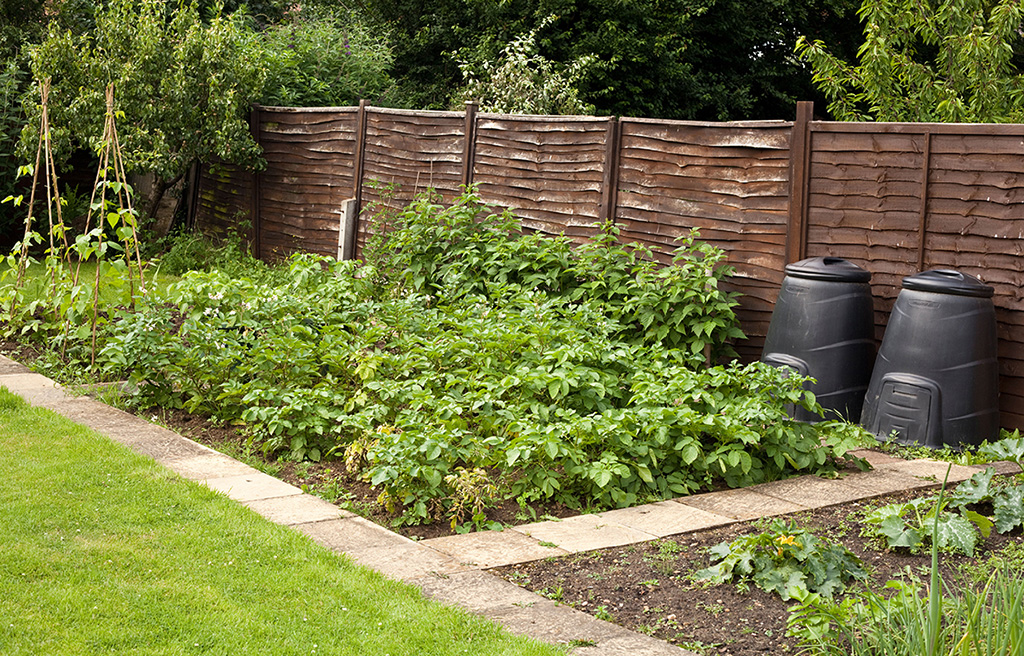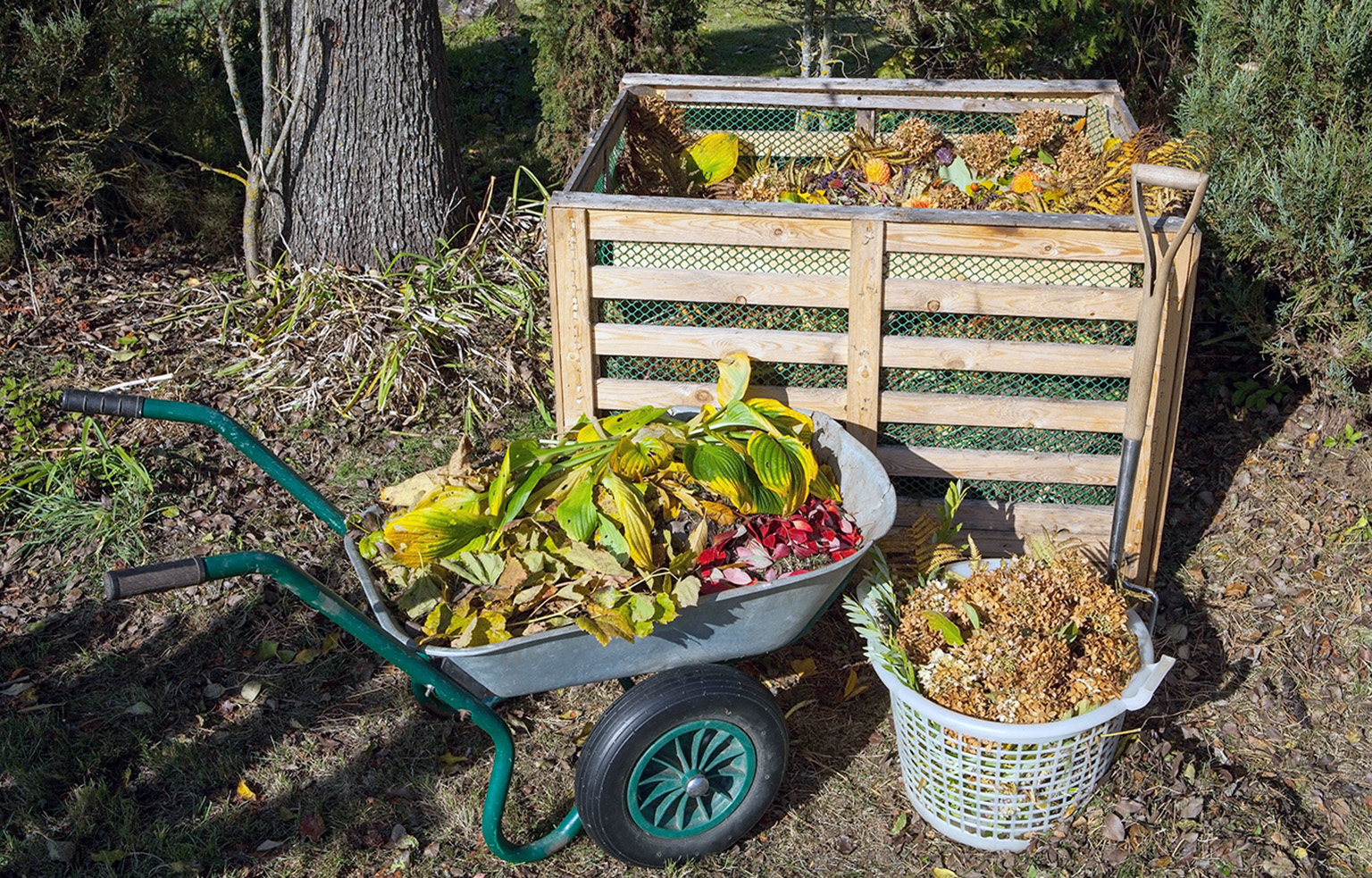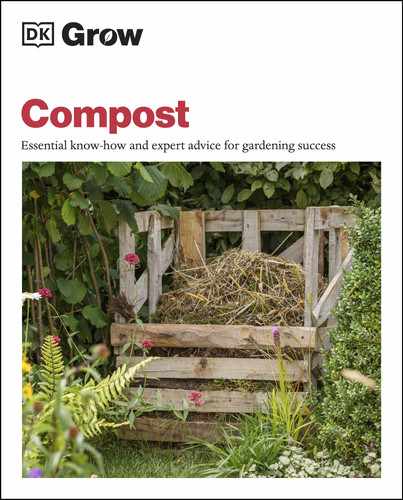Siting a heap or bin
There are a number of key factors to bear in mind when placing a heap or bin. Warmth will speed up the rate at which compost is produced, but in a small garden, putting your bin in a sunny spot that would otherwise be used for an attractive plant display may not be your best option. Also consider the appearance of your bin: unless it is a decorative model, position it carefully so that it is not an unintentional focal point from the house or patio. Keep your bin away from seating areas, too, which may be affected by the musty smell produced by fresh waste as it starts to decompose.

In a small garden where a utilitarian bin cannot be hidden easily, disguise it behind a bed of flowers.
Route to success
When positioning your bin, consider how you will access it with a barrowful of garden waste or scraps from the kitchen. Positioning it close to a pathway with a hard surface will make it easier to reach in wet weather, and will prevent a heavy wheelbarrow compacting the soil.
Avoid setting a compost bin on the far side of a lawn if you will need to use a route across the grass to reach it, as you may unwittingly create a muddy path of worn turf in the process. Choose a spot close enough to the kitchen to allow frequent trips back and forth, but not so close that you can smell any odors the compost produces from your back door. Remember to allow sufficient space around the bin to turn the contents, if you choose to do so. In a small garden, where it is difficult to hide your compost, opt for a decorative wooden bin or disguise it with a spray of flowers or shrubs.

Setting up a bin or two close to a paved path makes them easier to access with a wheelbarrow when the ground is wet.
Sun vs. shade
The optimum position for your bin will be an area that is sheltered from the prevailing winds and receives sun for a few hours each day. This will provide the right heat to keep the decomposers happy. If you do not have the ideal spot, you can also set up your bin in the shade, but remember that the cooler conditions will slow down the composting process, so you will need to be patient and wait a little longer for your black gold to form. Placing a heap in full sun is not recommended because the contents will dry out too quickly, which will kill some decomposers and encourage others to move out.

Composting will be quicker in a bin warmed by the sun for some of the day.
Soft landing
Place your bin on bare soil so that the decomposers can make their way into it and excess moisture can drain directly into the ground. If you have a bin with closed sides and a fitted lid, you can prevent vermin accessing the contents from below by lining the base with wire mesh. To do this, dig a shallow hole about 1in (2.5cm) deep and a little larger than the base of your bin. Line it with mesh cut to size and then place the bin on top. Vermin will be able to get into open-topped heaps or those with slatted sides, but you can deter them by not including cooked food, meat, or fish (see Recipes for Success).
On a terrace or in a paved courtyard garden, remove the paving stones in the area where you are proposing to install your bin, or place it on top of a raised bed filled with soil. Setting a bin directly on a hard surface is possible, but the contents will stain the paving and you will need to add a shovelful of garden soil or mature homemade compost to introduce the decomposers. Also make sure the liquid that seeps out of it won’t run off into a pond, where it will pollute the water.
TOP TIP Some pernicious weeds such as bindweed (Calystegia sepium) or horsetail (Equisetum arvense) will survive life in a cool compost heap, so check that there are no traces of them in the ground where you plan to set up your bin or heap.

Install your compost heap on bare ground so that the decomposers in the soil can find their way inside.
Making Compost | SITING A HEAP OR BIN
Bolster your beds
The area directly under a compost heap is incredibly fertile and will boost the productivity of the soil in garden beds and on allotments planted with hungry crops such as leafy greens. If you have space, place a bin or heap directly on a spare bed for a year or so and leave the contents to rot down, allowing the nutrient-rich liquid they produce to seep into the soil where it is needed. The finished compost can also be spread over the bed as a mulch before you plant it with the next season’s crops. You can then move the bin to another bed that needs enriching.

Two plastic bins are being used here to enrich the soil on a productive bed.
